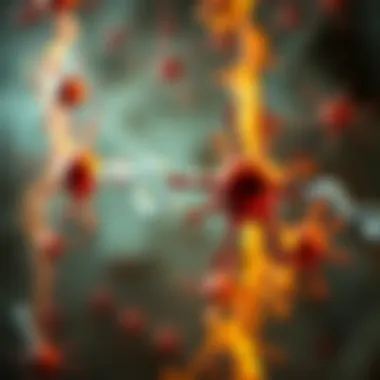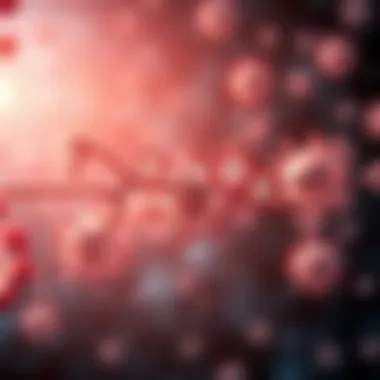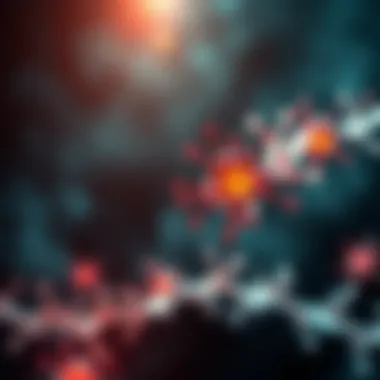Understanding the JAK Signaling Pathway and Its Impact


Intro
The Janus kinase (JAK) signaling pathway is not just a buzzword in the world of cellular biology; it plays a pivotal role in how our bodies respond to various stimuli, manage immune reactions, and maintain homeostasis. This intricate network of signaling molecules might seem like an unsung hero, but it's essentially the conductor of an orchestra that keeps many of our physiological processes in sync. Understanding the JAK signaling pathway requires looking back at its discovery and evolution, shedding light on how it has transformed our comprehension of immune responses and hematopoiesis.
Research Background
Overview of the Scientific Problem Addressed
The primary issue tackled by researchers regarding the JAK signaling pathway lies in its complexities and the multifaceted roles it plays within diverse biological contexts. This pathway is fundamentally linked to various cytokines, which are critical for both pro-inflammatory and anti-inflammatory responses. Imbalances or dysregulation within this signaling cascade can lead to a myriad of health complications, including autoimmune disorders and some forms of cancer. The nuances of how JAK regulates gene expression and interacts with other signaling pathways are essential for deciphering both normal physiology and disease pathology.
Historical Context and Previous Studies
The family of Janus kinases was first characterized in the early 1990s, when scientists stumbled upon their impressive ability to mediate signals from a host of cytokine receptors. This initial exploration set the groundwork for numerous studies that followed, contributing to a more refined understanding of the pathway.
The research landscape surrounding JAK has been steadily growing, particularly with the advent of targeted therapies. For instance, studies have shown that inhibiting these kinases can provide significant relief for patients suffering from rheumatoid arthritis and other inflammatory diseases. The role of JAKs in hematopoiesis has also been explored extensively, showcasing their utility in aiding the production of blood cells in the bone marrow.
As research has progressed, findings have revealed intricate details about the feedback mechanisms that regulate JAK signaling, highlighting the importance of fine-tuning in maintaining robust immune responses. The landscape is continually changing, making regular updates in this field essential for both academic investigation and clinical application.
Findings and Discussion
Key Results of the Research
Emerging findings regarding the JAK signaling pathway corroborate its essential nature in several biological processes. Recent studies have pinpointed key roles of specific JAK family members, such as JAK1, JAK2, and JAK3, each playing distinct functions depending on the cytokine involved. For instance, JAK2 has garnered attention due to its link to myeloproliferative neoplasms—disorders characterized by the overproduction of blood cells.
Interpretation of the Findings
Through this lens, the JAK pathway emerges as not merely a series of biochemical events; it is a finely-tuned system influenced by genetic, environmental, and intrinsic factors. The interplay with transcription factors, notably STAT proteins, further illustrates how signals are translated into functional responses that can alter cellular fate. Such insights have crucial implications for therapeutic developments, particularly in terms of designing selective JAK inhibitors that can intervene effectively in pathological conditions.
"The study of JAK signaling is not just about pathways; it’s about unlocking new avenues in treating previously insurmountable diseases."
The ongoing investigation into JAK signaling and its implications not only highlights the beauty of biological intricacies but also emphasizes the potential for breakthroughs in clinical practices. As we continue to peel back the layers surrounding this essential pathway, the promise for new therapeutic interventions becomes clearer than ever.
Useful Resources
- Wikipedia on JAK Signaling
- Britannica on Immune Signaling
- PubMed for Recent Research
- NCBI Gene on JAK Family
Intro to JAK Signaling Pathway
The Janus kinase (JAK) signaling pathway stands as a cornerstone in understanding myriad physiological processes, particularly in the realms of immunity and hematopoiesis. By diving deep into this intricate network of protein interactions, we grasp not only the fundamental workings of cellular signaling but also the implications for therapeutic advancements in various diseases. As researchers and practitioners in the field hone in on JAK signaling, it becomes glaringly apparent that unraveling its mechanisms can shed light on novel treatment strategies and interventions.
Overview of Signaling Pathways
Signaling pathways are, in a way, the languages through which cells communicate and respond to their environment. Imagine them as a complex game of telephone where every whisper echoes across the cellular landscape, influencing behaviors and outcomes. These pathways facilitate critical cell functions like growth, differentiation, and response to external stimuli. At the heart of many signaling pathways, the JAK pathway plays a pivotal role in mediating responses to cytokines—proteins essential for cell signaling, especially in the immune system.
Consider the path of a cytokine entering a cell. This interaction is akin to a key unlocking a door, signaling the cell to activate its internal machinery. Once activated, downstream components, including the signal transducers and activators of transcription (STATs), enter the scene, turning on genes that dictate cell function. Without the efficiency of signaling pathways, cells can misinterpret signals, leading to disorders such as autoimmune diseases and cancers. Hence, a thorough understanding of these frameworks, especially the JAK pathway, is invaluable for addressing such challenges.
Discovery of JAK Proteins
The journey of uncovering JAK proteins has greatly shaped our current understanding of cellular signaling. Discovered in the 1990s, these proteins emerged from a venture into interleukin signaling, gradually revealing their importance in immune responses and more. Named after the Roman god Janus—symbolizing duality—JAK proteins exist in various forms, each with specific roles in signaling.
Their discovery marked a turning point in molecular biology and medicine. Researchers uncovered that JAK proteins are indispensable adapters that help translate external signals into cellular actions.
"The discovery of JAK proteins opened an avenue for not just understanding immune responses but also potential therapeutic targets for a variety of diseases."
The significance of JAK proteins cannot be understated. They serve not just as facilitators of cytokine signaling, but as potential targets for medicinal intervention. By inhibiting JAK function, researchers have opened new doors for treating maladies where cytokine signaling goes awry, making the investigation into this pathway ever more essential in the context of drug development and precision medicine.
Molecular Components of the JAK Pathway
The understanding of the Janus kinase (JAK) signaling pathway is fundamentally tied to its molecular components. These components make up the building blocks that govern the pathway's functionality. From JAK proteins to cytokine receptors and STAT transcription factors, each plays a pivotal role not only in the activation of this pathway but also in defining its biological outcomes. Their interplay offers insights into potential therapeutic strategies and underscores the critical nature of this pathway in various physiological and pathological contexts.
JAK Family Members


The JAK family consists of four main members: JAK1, JAK2, JAK3, and TYK2. Each has distinct but overlapping functions crucial for the signaling process. JAK family members are primarily associated with specific receptors that bind to diverse cytokines. For instance, JAK2 is notably key in mediating signals from the erythropoietin receptor, essential for red blood cell production. Meanwhile, JAK3, often connected to immune responses, highlights the pathway's role in hematopoiesis and inflammation.
- JAK1: Primarily involved in the signaling of type I and II interferons, JAK1 plays a significant part in the immune response, particularly in the defense against viral infections.
- JAK2: This member is well-known for its role in hematopoietic cell growth and proliferation. JAK2 mutations are commonly linked to myeloproliferative disorders, underscoring its clinical importance.
- JAK3: This kinase is critical for lymphocyte development and function, mainly found in hematopoietic cells and influencing action during immune challenges.
- TYK2: Though similar to JAK1, TYK2 is unique for its role in mediating type I interferon signaling, demonstrating the functional diversity of the family.
Cytokine Receptors and Their Role
Cytokine receptors are integral to the JAK signaling pathway, acting as the conduits through which extracellular signaling molecules trigger intracellular responses. These receptors exist in varied forms and can either be single-chain or heterodimeric. Each type engages with specific JAK proteins, leading to their activation upon cytokine binding.
The role of these receptors goes beyond mere binding; they are essential for the specificity of signaling. For example:
- Type I Receptors: These generally associate with JAK1 and JAK2, facilitating signals from common hematopoietic cytokines. They are crucial for mediating responses such as cell survival and proliferation.
- Type II Receptors: Engaging primarily with JAK1 and TYK2, these receptors are central to interferon signaling, affecting immune regulation and viral defense mechanisms.
The engagement of cytokine receptors induces a series of conformational changes, which not only activate the corresponding JAK proteins but also lead to downstream signaling events that can result in gene expression changes.
Stat Proteins: Transcription Factors
Signal Transducer and Activator of Transcription (Stat) proteins are key transcription factors that act downstream of the JAK signaling pathway. Once JAKs are activated through the binding of cytokines to their receptors, they phosphorylate the Stat proteins, allowing them to dimerize and translocate to the nucleus where they can initiate gene transcription.
Stat proteins play diverse roles:
- Stat1: Involved in the response to interferons and is crucial for antiviral responses.
- Stat3: Notoriously recognized for its role in oncogenesis, as it is often persistently activated in many cancer types, contributing to processes like cell proliferation and survival.
- Stat5: Plays a vital role in hematopoietic signaling and is significant for the function and development of various blood cells.
Their ability to directly influence transcription represents a critical nexus through which JAK signaling impacts cellular functions and responses.
Understanding the molecular components of the JAK pathway is paramount in unraveling its implications in health and disease, particularly in contexts such as immune dysfunction and malignancies.
In summary, the molecular components of the JAK signaling pathway—JAKs, cytokine receptors, and Stat proteins collectively enable the myriad functions associated with cell signaling and response. An in-depth comprehension of these elements not only sheds light on the pathway's operational mechanisms but also informs future research and therapeutic interventions aimed at modulating this critical pathway.
Activation Mechanism of JAK Signaling
The activation mechanism of JAK signaling is a fundamental aspect to understand, particularly given its implications in various biological processes and disease states. Parsing the intricacies of this mechanism provides insights not only into cellular communication but also into therapeutic possibilities targeting JAK pathways. The activation hinges primarily on cytokines, which are crucial signaling molecules that link cellular signals to specific responses. Understanding how these activators function sets the stage for unraveling the complex web of interactions that govern immune responses, hematopoiesis, and disease.
Cytokine-Induced Activation
At the forefront of JAK signaling activation is the role of cytokines. These signaling proteins bind to specific receptors on the surface of cells, prompting a cascade of intracellular actions. For example, interleukins and interferons are well-known cytokines crucial for immune responses. When a cytokine binds to its corresponding receptor, it induces a conformational change. This physical alteration is what beckons the Janus kinases (JAKs) into action. In this context, you can think of JAKs like a set of gears that start turning when a driver (the cytokine) engages the machinery (the receptor).
When these receptors dimerize due to the bound cytokines, they create docking sites for JAKs. Each receptor typically associates with a JAK protein. This activation leads JAKs to phosphorylate tyrosine residues on the receptor itself, a process that essentially tags these sites to recruit downstream signaling partners. This process is paramount because without the correct phosphorylation, the signaling pathway remains dormant.
"Cytokine-induced activation is like the spark that ignites the engine of cellular signaling. Without that initial nudge, the entire machinery stays idle."
This initial phase is not just a single-step event. It is rather a sequence of interactions that lays the groundwork for a multitude of cellular functions that depend on how effectively the signal propagates. Notably, the distinction between various cytokine receptors informs specific biological outcomes, underlining the precision of the JAK signaling pathway's action.
Dimerization and Phosphorylation Events
Following the initial activation, the next significant step in JAK signaling involves dimerization and subsequent phosphorylation events. When the JAKs are activated by the binding of cytokines and receptor dimerization, they engage in phosphorylating specific tyrosine amino acids on the receptors. This step is crucial as it transforms the receptor into a multi-dimensional signaling platform that allows numerous cytoplasmic proteins to latch on—think of it as setting the stage for a vibrant performance where various actors (signaling molecules) join in to create a complex narrative.
The phosphorylated regions then serve as binding sites for proteins known as STATs (Signal Transducers and Activators of Transcription). Once recruited, STATs themselves get phosphorylated by JAKs. When activated, these proteins dimerize and translocate to the nucleus to initiate gene transcription. The entire dimerization and phosphorylation process essentially amplifies the initial message conveyed by the cytokines, translating extracellular signals into appropriate cellular responses.
These events showcase the elegant yet intricate choreography of the JAK signaling pathway. The regulation of these phosphorylation events is crucial; if not properly modulated, it can lead to pathological states, often seen in autoimmune diseases and cancers.
In summary, understanding the activation mechanism, particularly the cytokine-induced activation and the subsequent dimerization and phosphorylation events, provides foundational insights into how JAK signaling governs key biological functions and clinical implications. Each step is interconnected and emphasizes the pathway's sophisticated nature, reinforcing its importance in both health and disease.
Regulatory Mechanisms
In the intricate web of cellular communication, the regulatory mechanisms of the JAK signaling pathway play a pivotal role. They ensure that the pathway remains finely tuned, preventing dysregulation that could lead to diseases such as cancer or autoimmune disorders. The significance of these mechanisms cannot be overstated, particularly in how they balance the activation of signaling pathways while also implementing checks and balances to maintain cellular homeostasis.
Negative Feedback Loops
One of the most vital components of the regulatory framework is the negative feedback loop. This mechanism operates on a fundamental principle: what goes up must come down. In the context of the JAK pathway, once the JAK proteins have initiated a response, there are intrinsic systems in place to diminish that same response after the desired effect has been achieved. This is largely achieved through the activation of suppressors of cytokine signaling (SOCS) proteins.
"Negative feedback mechanisms ensure that signaling pathways do not spiral out of control, providing essential restraint within cellular processes."


For instance, when cytokines activate their respective receptors, this triggers the JAKs to phosphorylate specific STAT proteins. The phosphorylated STATs then migrate to the nucleus, where they stimulate the transcription of target genes. As the concentration of these target proteins rises, the SOCS proteins are synthesized, which in turn inhibit the JAKs by binding to them. This mechanism not only prevents excessive signaling but also protects tissues from potential damage.
Some critical points to consider about negative feedback loops include:
- Regulation of Cytokine Responses: They help in calibrating the immune response, preventing it from becoming either hyperactive or too weak.
- Restoration of Homeostasis: Following immune activation, these loops contribute to the return to a baseline state, ensuring cellular readiness for future stimuli.
- Pathological Implications: Dysregulation of feedback loops can lead to chronic inflammatory states, highlighting the importance of their integrity.
Inhibitory Proteins and Their Functions
Inhibitory proteins represent another layer of regulation in the JAK signaling pathway. These proteins act as guardians, ensuring that signaling does not veer into excessive territory. Like the security personnel at a high-stakes event, they monitor and control access, only allowing necessary signaling to proceed. Proteins like SOCS and protein inhibitors of activated STATs (PIAS) are prime examples.
SOCS proteins not only interact with JAKs, but they may also facilitate ubiquitination, marking these proteins for degradation in the proteasome. This process is essential to curtail ongoing signaling and makes way for new interactions. On the other hand, PIAS proteins inhibit STAT activity by preventing their binding to DNA. This further solidifies their role as negative regulators in JAK signaling.
Some points to highlight about inhibitory proteins include:
- Multiple Mechanisms of Action: Inhibitory proteins can function via various methods, including direct interference with signaling proteins and induction of transcriptional repression.
- Diverse Roles in Different Pathways: These proteins may be part of multiple signaling cascades, not just JAK, underscoring their widespread influence in cellular signaling.
- Therapeutic Targets: Because these proteins modulate the JAK pathway, they present potential targets for drug development, especially in conditions where regulation fails.
In summary, the regulatory mechanisms of the JAK signaling pathway, particularly through negative feedback loops and inhibitory proteins, are essential for maintaining cellular balance. They allow the pathway to respond efficiently to external stimuli while also mitigating excessive activation, thus preserving cellular integrity and preventing pathological states.
Biological Functions of JAK Signaling
The JAK signaling pathway plays a pivotal role in various biological functions that impact not just physiology but also pathology. Understanding these functions offers therapeutic insights into a multitude of diseases, particularly autoimmune disorders and cancers. This pathway connects extracellular signals, like those from cytokines, to intracellular responses, thereby influencing cell behavior, survival, and proliferation.
Role in Immune System Regulation
The immune system is a finely tuned orchestra, and the JAK signaling pathway acts as a crucial conductor.
**Key Elements:
- Cytokine Functionality: Cytokines such as interleukin-6 (IL-6) or interferon-gamma (IFN-γ) initiate responses through their receptor binding, leading to the activation of JAKs.
- T and B Cell Regulation: It governs T and B lymphocyte differentiation and survival. This could be a game changer in treating immunodeficiencies or hyperactive immune responses.
Through its detailed orchestration, the pathway ensures that immune cells communicate effectively. For instance, a malfunction in JAK signaling can lead to diseases such as rheumatoid arthritis or systemic lupus erythematosus, where immune responses become maladaptive. The regulation by JAKs encourages a response to pathogens while preventing overactivity that could harm tissues.
“The immune system’s harmony depends heavily on the synchrony of signals driven by the JAK pathway.”
Involvement in Hematopoiesis
Hematopoiesis, the process of blood cell formation, relies on a precise network of signaling mechanisms, and the JAK pathway is at the heart of this process.
Benefits and Considerations:
- Stem Cell Differentiation: JAK signaling activates transcription factors that promote the differentiation of hematopoietic stem cells into specific blood cell lineages. Cytokines like erythropoietin stimulate red blood cell production while others drive the production of white blood cells.
- Response to Hypoxia: In conditions of low oxygen, JAK-mediated erythropoiesis kicks into gear to replenish red blood cells. Dysfunction in this could lead to anemias or leukemia, where the balance of blood cell types is compromised.
It becomes evident that JAK signaling is not just a background player; it's central in ensuring a balanced production of blood cells, which is vital for overall health. For example, targeting the JAK pathway in therapeutic strategies can enhance recovery during bone marrow suppression after chemotherapy.
Impact on Cell Proliferation and Differentiation
JAK signaling also significantly influences cell proliferation and differentiation across various tissue types, acting almost like a switch that can be flipped under specific circumstances.
Important Aspects:
- Cell Cycle Regulation: JAK signaling can promote the transition from one phase of the cell cycle to another, thus promoting cellular growth and division. This is particularly crucial in developmental biology and tissue repair.
- Oncogenesis: Conversely, aberrant JAK signaling can contribute to tumorigenesis in cancers. The pathway's deregulation has been implicated in various malignancies, providing a target for developing more effective cancer therapies, like JAK inhibitors.
In essence, the mechanisms orchestrated by JAK proteins not only impact normal physiological development but also underlie pathological conditions when things go awry, offering a dual narrative in their functions.
In summary, the diverse biological functions of JAK signaling, from immune regulation to hematopoiesis and cell proliferation, underscore its importance in health and disease. Understanding these facets opens the door for novel therapeutic opportunities that could significantly improve patient outcomes.
Clinical Implications of JAK Signaling
The Janus kinase (JAK) signaling pathway wields significant influence in a variety of clinical contexts, particularly concerning immunological and oncological disorders. This pathway's intricate mechanisms make it a critical focus for ongoing research and therapeutic development. Understanding the clinical implications of JAK signaling leads to insights about its role not only in disease progression but also in possible treatment strategies. From autoimmune diseases to cancer, JAK operates at the crossroads of multiple cellular reactions, making interventions in this pathway both necessary and opportunistic.


JAK Inhibitors in Therapy
JAK inhibitors have turned some heads in the medical community, and rightly so. These agents target the JAK family of enzymes, effectively blocking the signaling cascade that follows activation by cytokines. For instance, tofacitinib and baricitinib have found notable applications in treating rheumatoid arthritis and other inflammatory conditions. What's particularly intriguing is how these inhibitors can modulate immune responses without completely halting them, which is a tricky balance to strike.
- Benefits of JAK Inhibitors:
- Rapid Onset of Action: Unlike traditional DMARDs (Disease-Modifying Antirheumatic Drugs), which can take months to show effects, JAK inhibitors can lead to a rapid improvement in symptoms.
- Improved Quality of Life: Patients often report a significantly enhanced quality of life due to reduced pain and improved functionality.
- Targeted Mechanism: Unlike broader immunosuppressants, JAK inhibitors specifically target pathways involved in inflammation.
However, prescribing them comes with a set of considerations. Side effects such as increased risk of infections and changes in liver enzyme levels must be monitored closely.
JAK Pathway in Autoimmune Diseases
Autoimmune diseases are a major area of concern and research in the context of JAK signaling. Conditions like psoriasis, lupus, and multiple sclerosis have shown varying involvement of JAK proteins in their pathophysiology. For instance, interleukin-23 (IL-23), a cytokine that heavily relies on the JAK pathway, has been implicated in the development of psoriasis. Here’s how JAK signaling plays a role:
- Cytokine Storm: In autoimmune diseases, the body's immune response can become dysregulated, leading to excessive cytokine production—often referred to as a cytokine storm. JAK inhibitors can temper this response, providing a potential therapeutic avenue.
- Personalized Medicine Approach: By identifying which specific JAK pathways are active in various patients, clinicians can tailor treatments more effectively.
- Studies demonstrate that targeting JAK has reduced inflammation and improved outcomes in mouse models of autoimmune diseases.
JAK Signaling and Cancer
Cancer is perhaps one of the most intriguing areas concerning JAK signaling, as the pathway can function in both promoting and suppressing tumor growth, depending on the context. In some cancers, such as myeloproliferative neoplasms, mutations in JAK2 have been implicated directly in disease pathology. The pathways involved often intersect with key processes like angiogenesis, immune evasion, and cell survival.
- Implications for Therapy:
- Combination Treatments: Using JAK inhibitors in conjunction with traditional chemo or immunotherapy helps target multiple pathways simultaneously, which could enhance efficacy.
- Biomarkers for Treatment Decisions: Monitoring JAK signaling's status in tumors could serve as a predictive biomarker, aiding in assessing responses to particular cancer therapies.
"Understanding the precise roles of JAK signaling in cancer paves the way for developing more focused and potentially effective treatments."
In summary, the clinical implications of JAK signaling extend beyond mere pathway functioning; rather, they open doors for innovating treatment protocols that address complex diseases like autoimmune disorders and cancer. The ability to modulate this pathway through inhibitors not only represents a significant scientific advancement but also shows great promise for improving patient outcomes in various disease states.
Research Advances and Future Directions
The exploration of the JAK signaling pathway continues to hold significant promise as our understanding of its mechanisms deepens. This not only paves the way for potential therapeutic innovations but also enhances our insights into its role in various pathologies. Ongoing research is critical; it fuels the relentless pursuit of knowledge regarding cellular signaling and its effects on health and disease.
One of the noteworthy aspects influencing future studies is the shift towards precision medicine. Instead of a one-size-fits-all approach, there’s a growing recognition of the need for tailored treatments based on individual patient profiles. The JAK pathway, due to its pivotal role in conditions such as autoimmune disorders and cancers, presents a compelling target. One of the benefits of delving into this specificity is the potential to improve treatment outcomes while minimizing adverse effects.
Current Research Trends
Current trends in JAK pathway research are varied and multifaceted. They include:
- Investigation of Novel JAK Inhibitors: The pharmaceutical industry is seeing a surge in the development of new JAK inhibitors with enhanced selectivity and efficacy. Researchers are keen on understanding how these molecules interact not only within the JAK pathway but also with other signaling networks.
- Understanding Biomarkers for Treatment Responses: Identifying biomarkers that can predict how patients will respond to JAK-targeted therapies is of utmost importance. This research aims to ensure that individuals receive the most appropriate therapies according to their unique molecular profiles.
- Influence of the Microenvironment: Another trend is studying how the bone marrow microenvironment can influence JAK signaling in hematopoietic conditions. The interplay between immune cells and the local cellular milieu has implications for both disease progression and therapy efficacy.
Potential Areas for Exploration
As we look towards future studies, several areas are ripe for exploration:
- Long-term Effects of JAK Inhibition: Understanding the long-term consequences of JAK inhibition on immune function is crucial. This area can shed light on the balance between therapeutic benefits and potential risks, such as increased susceptibility to infections.
- Crosstalk with Other Pathways: The JAK pathway doesn't exist in isolation. Investigating how it interacts with other signaling pathways, like the MAPK or NF-kB pathways, could reveal intricate networks of cellular communication that are vital for understanding pathology and therapy.
- Personalized Therapeutic Strategies: Siddling into the realm of personalized medicine, a promising direction includes developing individualized treatment strategies based on genetic and epigenetic profiles that influence JAK signaling.
- Exploration of Non-Coding RNAs: Another intriguing area is the role of non-coding RNAs in regulating JAK pathway components. Research here could unlock novel regulatory mechanisms that inform both disease understanding and treatment strategies.
Finale
The exploration of the JAK signaling pathway is not just an academic endeavor; it has far-reaching implications that resonate through various fields such as immunology, oncology, and hematology. Understanding the mechanisms of this pathway sheds light on how immune responses are regulated and how blood cell production is influenced by cytokines. This knowledge isn't merely theoretical; it stands to benefit real-world applications, potentially leading to groundbreaking treatments and therapies.
Summary of Key Points
To summarize, the JAK signaling pathway operates through a complex interplay of cytokines, JAK family proteins, and Stat transcription factors. Here are the main takeaways:
- JAK Signaling Activation: The pathway is triggered through cytokine receptor interactions that result in JAK activation, leading to Stat protein phosphorylation.
- Biological Functions: It plays vital roles in immune system regulation, hematopoiesis, and influencing cell proliferation and differentiation.
- Clinical Relevance: JAK inhibitors are increasingly used in therapeutic settings, especially for autoimmune diseases and certain malignancies.
- Research Advances: Continuous study is revealing new insights and potential therapeutic targets that could revolutionize treatments.
The Ongoing Significance of JAK Pathway Research
The significance of ongoing research into the JAK signaling pathway cannot be overstated. It is a key driver in understanding many complex health issues:
- Autoimmune Diseases: As scientists peel back the layers, new therapeutic options for diseases such as rheumatoid arthritis and lupus are becoming clearer.
- Cancer Research: The role of JAK signaling in oncogenesis offers pathways to novel cancer therapies, providing hope for patients facing difficult prognoses.
- Pharmaceutical Development: The push for more sophisticated JAK inhibitors continues, spurring advancements in pharmacotherapy that could improve quality of life for numerous patients.
In essence, the continued investigation into the JAK pathway is pivotal for fostering better health outcomes and enhancing our fundamental understanding of human biology. As this research grows, it stands to open doors to innovative treatments, redefining the future of how we approach disease management and patient care.
"Understanding the JAK pathway offers a gateway to addressing some of the most pressing medical challenges of our time, from autoimmune disorders to cancer therapy."
For further reading, resources such as National Institutes of Health and Nature Research Journals provide valuable insights into the latest developments in this area.







